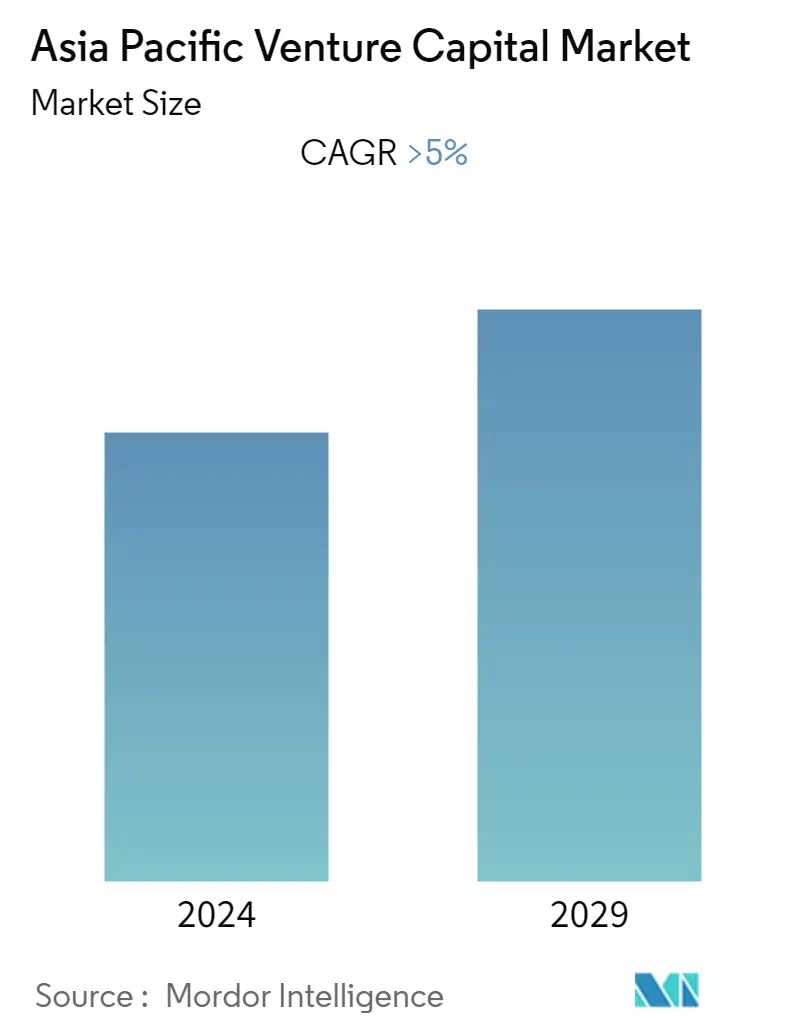Market Size of Asia Pacific Venture Capital Industry

| Study Period | 2020 - 2029 |
| Base Year For Estimation | 2023 |
| Forecast Data Period | 2024 - 2029 |
| Historical Data Period | 2020 - 2022 |
| CAGR | > 5.00 % |
| Market Concentration | Medium |
Major Players
*Disclaimer: Major Players sorted in no particular order |
Asia Pacific Venture Capital Market Analysis
VC funding activity in the APAC region remained inconsistent during the COVID-19 pandemic in the second quarter of 2020. While VC deal volume, after decreasing from 621 in April to 463 in May rebounded marginally to 476 in June, deal value registered consistent decrease from US$8.5bn in April to US$7.6bn in May and US$6.6bn in June.
Edtech and online grocery retail are areas, which have been gaining significance with enhanced use of online platforms during COVID-19. Companies active in healthcare and medical systems space are also gaining attention. China continued to top the venture capital (VC) funding activity both in terms of volume as well as value and was way ahead of its peer countries in the Asia-Pacific (APAC) region during the second quarter (Q2) of 2020.
China continued to maintain its dominance with the country accounting for close to 50% of the total VC deal volume in Q2. China's share as a proportion of total deal value was also above the 70% mark during all the three months of Q2. Some of the notable deals announced in China during Q2 included USD 1 billion raised by COVID-19 testing equipment maker MGI Tech; USD 750 million raised by online learning platform Zuoyebang; and USD 500 million raised by online grocery start-up MissFresh.
India, Japan, South Korea and Singapore were the other top four markets by deal volume while India, Singapore, Japan and Australia were the other top four markets in terms of value. Most of the countries in the region showcased some recovery signs in June but are yet to touch April levels.
Asia Pacific Venture Capital Industry Segmentation
Venture capital in Asia has played a significant economic role in the region's development and is expected to play an even more significant role in the future. Asia's start-up scene is presenting increased investment potential as the pandemic has shifted dynamics for the long term, one of the region's leading venture capital firms said. The Asia Pacific Venture Capital Market can be segmented by the various countries in the region ( China, India, Japan, South Korea, Indonesia, Malaysia and others), by the Industry or sector invested in ( fintech, logistics or LogiTech, healthcare, IT, education & EdTech, and others), and by stage ( early stage, growth & expansion stage, and late stage).
Asia Pacific Venture Capital Market Size Summary
The Asia Pacific venture capital market has shown resilience and adaptability, particularly in the face of the COVID-19 pandemic, which initially caused fluctuations in funding activity. Despite these challenges, sectors such as edtech, online grocery retail, and healthcare have gained prominence, driven by increased digital engagement. China has maintained a leading position in the region, dominating both the volume and value of VC deals, with significant investments in technology and online platforms. Other key markets include India, Japan, South Korea, and Singapore, which have also demonstrated robust VC activity. The pandemic has accelerated the shift towards digital banking and cashless transactions, with fintech startups playing a crucial role in this transformation. This shift has led to increased investments in digital payments, tech-driven insurance, and wealth management solutions, highlighting the dynamic nature of the market.
In 2020, India experienced a surge in VC investments, with significant funding directed towards consumer tech, SaaS, and fintech sectors. The country saw notable fundraising activities, with major funds closing new investments despite the pandemic. The competitive landscape of the Asia Pacific venture capital market is characterized by the presence of both international and domestic players, offering substantial growth opportunities. The market is expected to continue its upward trajectory, driven by the recovery of investment activity to pre-COVID levels and the ongoing interest in emerging technologies and digital solutions. Noteworthy investments, such as those in XPeng and Razorpay, underscore the region's potential and the strategic focus on frontier technologies and digital finance.
Asia Pacific Venture Capital Market Size - Table of Contents
-
1. MARKET DYNAMICS
-
1.1 Market Overview
-
1.1.1 Development of Asia VC
-
1.1.2 Pulse of Various Rounds of VC
-
1.1.3 Tech VCs Domination in the Region
-
1.1.4 Differences in Investment Dynamics
-
1.1.5 Regulatory Requirements across the Region
-
1.1.6 Impact of Individual VCs and VC Firms
-
-
1.2 Market Drivers
-
1.3 Market Restraints
-
1.4 Value Chain / Supply Chain Analysis
-
1.5 Porters 5 Force Analysis
-
1.5.1 Threat of New Entrants
-
1.5.2 Bargaining Power of Buyers/Consumers
-
1.5.3 Bargaining Power of Suppliers
-
1.5.4 Threat of Substitute Products
-
1.5.5 Intensity of Competitive Rivalry
-
-
1.6 Impact of Covid 19 on the Industry
-
-
2. MARKET SEGMENTATION
-
2.1 By Country
-
2.1.1 China
-
2.1.2 India
-
2.1.3 Japan
-
2.1.4 South Korea
-
2.1.5 Indonesia
-
2.1.6 Malaysia
-
2.1.7 Others
-
-
2.2 By Industry/ Sector
-
2.2.1 Fintech
-
2.2.2 Logistics and Logitech
-
2.2.3 Healthcare
-
2.2.4 IT
-
2.2.5 Education and Edtech
-
2.2.6 Others
-
-
2.3 By stage
-
2.3.1 Early Stage
-
2.3.2 Growth and Expansion
-
2.3.3 Late Stage
-
-
Asia Pacific Venture Capital Market Size FAQs
What is the current Asia Pacific Venture Capital Market size?
The Asia Pacific Venture Capital Market is projected to register a CAGR of greater than 5% during the forecast period (2024-2029)
Who are the key players in Asia Pacific Venture Capital Market?
East Ventures, 500 Durian, SG INNOVATE, Sequoia Capital, Insignia Ventures Partners, Wavemaker Partners, Global Founders Capital and SEEDS Capital are the major companies operating in the Asia Pacific Venture Capital Market.

